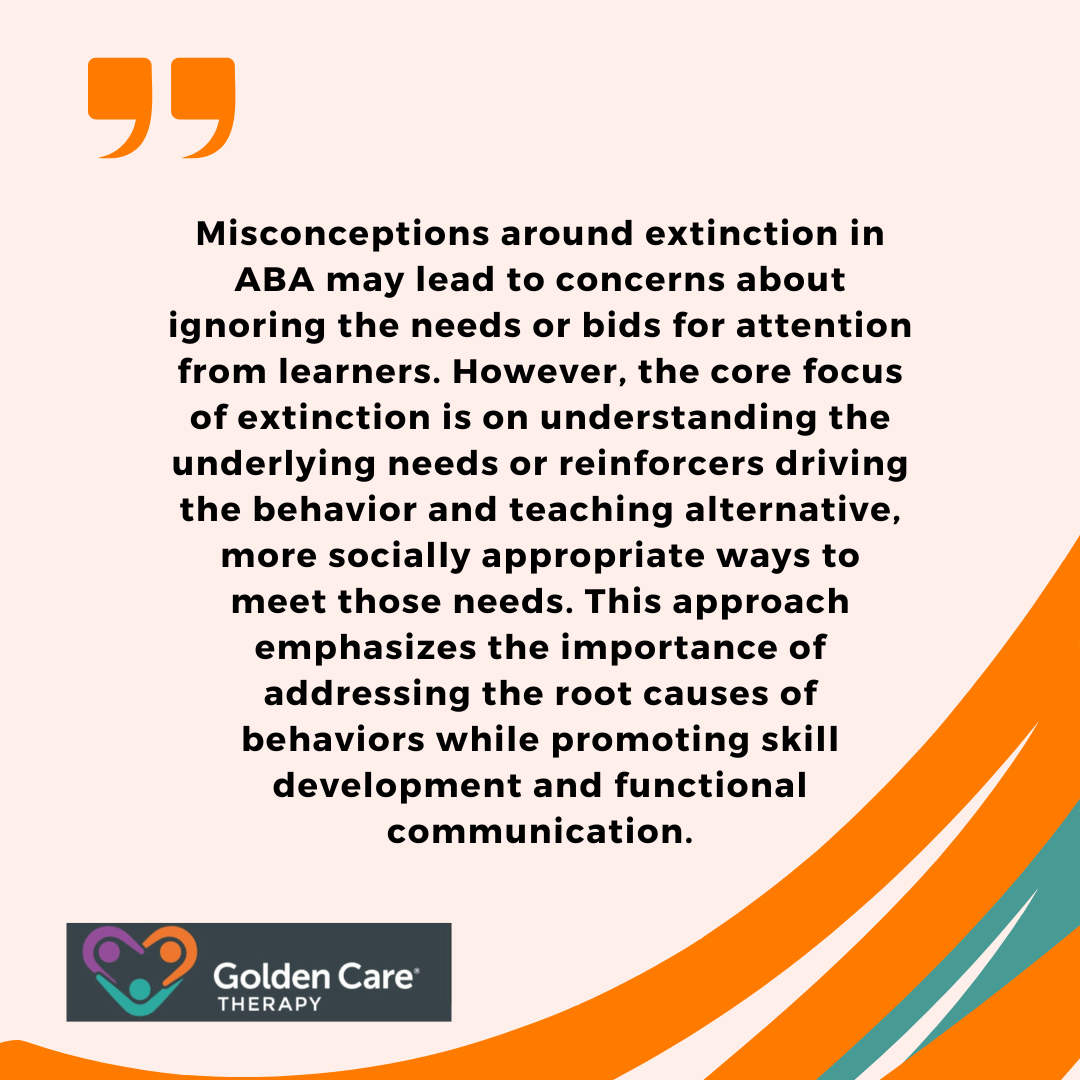
Table of Contents
Extinction is a key concept in Applied Behavior Analysis that helps address and modify behaviors. It refers to the process of reducing or eliminating a behavior by stopping the reinforcement that maintains it.
When a behavior that was previously rewarded no longer gets attention or rewards, it eventually fades away. Understanding extinction can be crucial for creating effective strategies to support behavioral change.
This overview will provide a clear explanation of what extinction means in ABA and how it can be applied to achieve positive outcomes.
What is Extinction in ABA Therapy?
Extinction in the context of ABA therapy revolves around the strategic cessation of reinforcing a behavior that was previously reinforced.
It involves deliberately halting the reinforcement of a specific behavior, such as intentionally ignoring a behavior not to avoid challenging situations but to reshape engagement with the behavior while still providing essential attention and support.
Misconceptions surrounding extinction may lead to the belief that it entails disregarding the needs or requests for attention from learners. However, the essence of extinction in ABA is rooted in comprehending the underlying needs or synthesized reinforcers and teaching alternative skills that enable learners to satisfy their needs more appropriately.
The primary objective of extinction in ABA therapy is the gradual fading and eventual elimination of undesired behaviors. This process entails refraining from reinforcing undesirable behaviors while concurrently utilizing positive reinforcement to promote desirable behaviors.
Applied Behavioral Analysis emphasizes that extinction is a technique used to decrease or eradicate problem behaviors by discontinuing the reinforcement that sustains them. This method involves identifying the function of the behavior and ensuring that the individual no longer accesses the reinforcer, thereby extinguishing the behavior.
For instance, if a child typically gains attention through tantrums, the extinction procedure would involve withholding attention when tantrums occur.
Understanding the nuanced application of extinction within ABA therapy is essential for fostering behavior change, facilitating the development of adaptive skills, and promoting positive outcomes for individuals undergoing therapy.
Implementing Extinction Strategies in ABA Therapy
Implementing extinction strategies involves ceasing to reinforce a behavior that was previously reinforced to reduce the frequency of that behavior over time. This approach is a fundamental component of behavior modification and plays a significant role in shaping desired behaviors.
The process of extinction involves carefully identifying the target behavior that is no longer going to be reinforced. By systematically withholding the reinforcement that previously maintained the behavior, individuals are encouraged to seek alternative, more adaptive ways to achieve their goals and needs.
However, it’s important to note that extinction is typically not a standalone intervention; it is often paired with positive reinforcement strategies to promote the learning of new, appropriate behaviors.
When implementing extinction strategies in ABA therapy, it is crucial to consider the feasibility and safety aspects of this approach. While extinction can be effective in reducing unwanted behaviors, it is essential to ensure that the procedure is practical and can be consistently applied.
In addition, safety considerations are important to prevent any adverse reactions or unintended consequences.

Combining extinction with positive reinforcement techniques is a best practice in ABA therapy. While extinction serves to reduce undesired behaviors, positive reinforcement reinforces desired behaviors, creating a balanced approach to behavior management.
This combination ensures that individuals receive clear feedback on their behaviors and are motivated to engage in more suitable actions.
Application in ABA Therapy
The application of extinction techniques within ABA therapy and the positive reinforcement approach play significant roles in addressing behaviors and fostering positive change in individuals with autism.
Extinction is implemented thoughtfully and requires meticulous planning, gradual removal of reinforcers, teaching of replacement behaviors, continuous reflection on outcomes, and adaptations as needed.
In ABA therapy, extinction involves the fading away and eventual elimination of undesirable behaviors through the discontinuation of the reinforcement that sustains them.
When applying extinction in ABA therapy, practitioners may choose to deny the individual access to specific items or activities that previously served as reinforcers for the unwanted behavior.
That said, caregivers and therapists should remain consistent and patient during the extinction process, as the undesired behavior may initially escalate before diminishing.
Positive Reinforcement Approach
Contrary to common misconceptions, the positive reinforcement approach in ABA therapy does not involve ignoring the needs or bids for attention from individuals with autism. Instead, this approach focuses on understanding the underlying needs or synthesized reinforcers and teaching replacement skills to address the unwanted behavior effectively.
Incorporating positive reinforcement strategies into ABA therapy entails not only reducing disruptive behaviors but also emphasizing the enhancement of positive replacement skills.
Reinforcing desirable behaviors and providing appropriate rewards is crucial for caregivers and ABA professionals to encourage individuals with autism to engage in behaviors that are more socially acceptable and constructive.

Challenges and Considerations
Extinction in ABA therapy comes with unique challenges and requires careful consideration to ensure successful outcomes for individuals undergoing behavior modification.
When integrating extinction into ABA therapy, practitioners and caregivers must approach the process with patience and consistency. It is essential to be aware that during the initial stages of extinction, the undesirable behavior may exhibit a temporary increase in frequency, duration, or intensity.
This temporary surge in undesired behavior is known as an extinction burst.
The implementation of extinction strategies necessitates a well-thought-out and individualized approach. This involves meticulous planning, gradual removal of reinforcers that maintain the undesired behavior, teaching of replacement behaviors, continuous evaluation of outcomes, and flexibility to make adjustments as needed.
Before initiating the extinction process, ABA practitioners must analyze and consider several factors, including the individual’s unique characteristics, the environment in which the behavior occurs, and the specific replacement behaviors that need to be reinforced through positive reinforcement.
This personalized approach ensures that the extinction process is executed effectively and promotes long-lasting behavior change.
Conclusion
Understanding extinction in ABA is like learning how to guide behavior more effectively. By removing rewards that encourage unwanted behaviors, we can help individuals make positive changes and build better habits.
Needless to say, it’s a powerful tool when used thoughtfully, helping to create a more supportive and understanding environment for everyone involved. For families seeking specialized support, Golden Care Therapy offers exceptional services through their ABA centers in New York, New Jersey, Georgia, and Indiana.
Contact us today to discover how our dedicated team can assist you and your loved ones in achieving their goals.
Sources:
- Video Modeling and Its Impact on ABA Learning - September 27, 2024
- Strategies for Teaching Turn-Taking in Autism - September 27, 2024
- Understanding Social Boundaries in Autism - September 27, 2024
